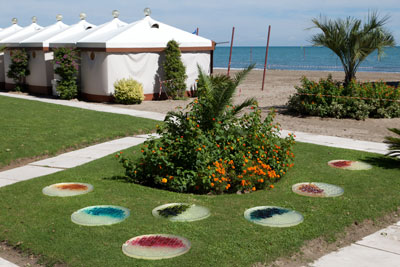ITALY - STEFANO FIORESI

“What is a manhole cover if it isn’t really the link between the world above and the world of archaeology below us?” says Stefano Bottoni, creator of the International Manhole Cover Museum in Ferrara housing a collection of manhole covers that is one of a kind in the world. He continues “Isn’t the manhole cover maybe a work of art in itself, on the one hand a simple product and on the other a piece of artistic bas-relief?”.
Stefano Fioresi has also perceived manhole covers to potentially be an unusual, singular art form, which tell a story through their images, decorations, abbreviations and symbologies. They make a statement about the place where they come from. The manhole covers of Rome bear the fasces lictoriae (bundle of rods), those of Danzig bear a crown and double cross, a manhole from Valencia has the Fagundo Bacardi bat brand just like the rum of the same name, Berlin’s manhole cover bears images of the city’s main historical buildings set in a circle, from the Reichstag to the Brandenburg Tor and the Prague manhole cover carries a crest showing the Malà Strana Bridge Tower.
A city addict with metropolitan imagination, Fioresi wasn’t satisfied with just plumbing the depths of the places, faces and symbols of the urban landscape and representing them over and over again, using different views and frames. Like some kind of modern archaeologist, he analysed the most typical find in urbanized civilization, manhole covers. This time it’s not just manhole covers from any old place, it’s the ones that belch out steam in the crazy city, Rem Koolhaas’ Delirious New York, the Post-modern city which has always been the favourite destination of Fioresi’s aesthetic explorations.
His bas-relief texture reproduces the characteristic relief grid of vertical and horizontal bars with N.Y.C. SEWER written in the centre. The series of sculptural elements are represented in a typical Neo-Pop style, creating multiple sequences that vary in a splodge of primary colour (red, blue and yellow) that merely taints a portion of the surface. These tache or coloured spots appear to come from a fissure or crack in the cast-iron mount, which makes the colour spill out in place of the typical New York steam.
It’s is yet another occasion for the artist to reinforce the idea of the need to not only play around with images but also the design elements of the urban fabric and also to personalize and embellish the outside landscape with this so-called Manhole Cover Art formula which has so much affinity with the techniques of Street Art in the city streetscape.
Text by Chiara Canali